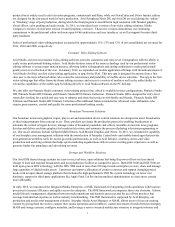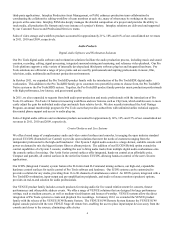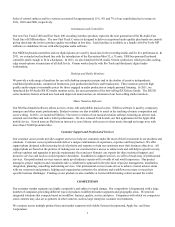Avid 2011 Annual Report Download - page 18
Download and view the complete annual report
Please find page 18 of the 2011 Avid annual report below. You can navigate through the pages in the report by either clicking on the pages listed below, or by using the keyword search tool below to find specific information within the annual report.13
integrating alternative third-party technology or developing our own substitute technology. In the interim, sales of our products
may be delayed or suspended or we may be forced to distribute our products with reduced feature sets or functionality.
Lengthy procurement lead times and unpredictable life cycles and customer demand for some of our products may result
in significant inventory risks.
With respect to many of our products, we must procure component parts and build finished inventory far in advance of product
shipments. Certain of these products may have unpredictable life cycles and encounter rapid technological obsolescence as a
result of dynamic market conditions. We procure product components and build inventory based upon our forecasts of product
life cycle and customer demand. If we are unable to accurately forecast product life cycle and customer demand or unable to
manage our inventory levels in response to shifts in customer demand, the result may be insufficient, excess or obsolete product
inventory. Insufficient product inventory may impair our ability to fulfill product orders and negatively affect our revenues, while
excess or obsolete inventory may require a write-down on products and components to their net realizable value, which would
negatively affect our results of operations.
Our revenues and operating results depend significantly on our third-party reseller and distribution channels.
We distribute many of our products indirectly through third-party resellers and distributors. We also distribute products directly to
end-user customers. Successfully managing the interaction of our direct and indirect channel efforts to reach various potential
customer segments for our products and services is a complex process. For example, in response to our direct sales strategies or
for other business reasons, our current resellers and distributors may from time to time choose to resell our competitors' products
in addition to, or in place of, ours. Moreover, since each distribution method has distinct risks and gross margins, our failure to
identify and implement the most advantageous balance in the delivery model for our products and services could adversely affect
our revenue and gross margins and therefore our profitability.
In addition, some of our resellers and distributors have rights of return, as well as inventory stock rotation and price protection.
Accordingly, reserves for estimated returns and exchanges, and credits for price protection, are recorded as a reduction of
revenues upon applicable product shipment, and are based upon our historical experience. To date, actual returns of relevant
products have not differed materially from our management's estimates. However, our reliance upon indirect distribution methods
may reduce visibility to demand and pricing issues, and therefore make forecasting more difficult and to the extent that returns
exceed estimates, our revenues and operating results may be adversely affected.
Our intellectual property and trade secrets are valuable assets that may be subject to third-party infringement and
misappropriation.
As a technology company, our intellectual property and trade secrets are among our most valuable assets. Infringement or
misappropriation of these assets results in lost revenues to us and thereby ultimately reduces their value. We rely on a
combination of patent, copyright, trademark and trade secret laws, as well as confidentiality procedures, contractual provisions
and anti-piracy technology in certain of our products to protect our intellectual property and trade secrets. Most of these tools
require vigilant monitoring of competitor and other third-party activities and of end-user usage of our products to be effective.
These tools may not provide adequate protection in all instances, may be subject to circumvention, or may require a vigilance that
in some cases exceeds our capabilities or resources. Additionally, our business model is increasingly focused on software
products and as we offer more software products our revenues may be more vulnerable to loss through piracy, which could result
in revenue losses for us. While we may seek to engage with those potentially infringing our intellectual property to negotiate a
license for use, we also may seek legal recourse. The legal regimes of certain countries in which we operate may not protect our
intellectual property or trade secrets to the same extent as do the laws of the United States. Regardless of jurisdiction, assuming
legal protection exists and infringement or misappropriation is detected, any enforcement action that we may pursue could be
costly and time-consuming, the outcome will be uncertain, and the alleged offender in some cases may seek to have our
intellectual property rights invalidated. If we are unable to protect our intellectual property and trade secrets, our business could
be harmed.
Our results could be materially adversely affected if we are accused of, or found to be, infringing third parties' intellectual
property rights.
Because of technological change in our industry, extensive and sometimes uncertain patent coverage, and the rapid issuance of
new patents, it is possible that certain of our products or business methods may infringe the patents or other intellectual property
rights of third parties. We have received claims and are subject to litigation alleging that we infringe patents owned by third
























